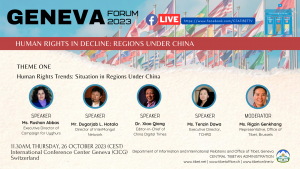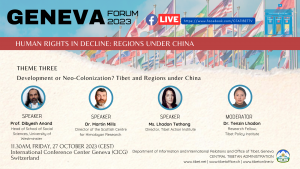The ethnic policies pursued by the Chinese Communist Party in its so-called autonomous regions have been primarily rooted in the principles of securitization, surveillance, and assimilation. Notably, the most oppressive measures have been applied upon occupied territories in Tibet, East Turkestan, Southern Mongolia where the CCP has implemented a range of strategies including the imposition of language restrictions and colonial boarding schools, the deliberate obliteration of sacred religious sites and institutions, the extensive gathering of genetic data, and the pervasive deployment of surveillance systems designed to restrict the flow of information and freedom of movement.
China’s assault on Uyghur, Tibetan, Mongolian culture and others is a multi-faceted campaign that targets the very core of these peoples’ identities. In occupied Tibet, the government has systematically synchronized enforced policies with the ultimate goal of erasing the unique identity, culture, and language of the Tibetan people. This has been facilitated through various means, such as promoting intermarriage between Han Chinese and Tibetans, state sanctioned Chinese migrants transfer, the compulsory resettlement of nomadic and rural communities, the establishment of colonial boarding schools along with forced closures of private Tibetan schools and tuition classes.
Over a million Tibetan children aged 4 to eighteen are being separated from their families and compelled to attend state-run boarding schools. Similar network of state-run boarding schools is also reported to run in East Turkistan with detrimental effect on cultural, religious and linguistic identities and loss of connection with families and communities as confirmed by statements of three UN human rights experts last month. In 2020, the Chinese Government introduced the “Second Generation Bilingual Education,” in Southern Mongolia, a policy that was already imposed in East Turkistan in 2017 and Tibet in 2018. In the same year, a regional training program promoting a common Chinese identity was initiated. In September 2023, the Chinese government chose to replace mother tongue education in Southern Mongolia with Chinese, contradicting Article 4 of the PRC Constitution, which guarantees ethnic groups the right to use and develop their languages.
In the Uyghur region, between one to two million Uyghurs and Turkic peoples have been detained in Vocational Skills Education and Training Centers (VSETCs) and other facilities and now being used as forced labor in Chinese factories and subject to Chinese propaganda and physical abuse. Accounts from former detainees, including those compelled to serve as Mandarin instructors, along with Chinese Communist Party propaganda, confirms that Mandarin study plays a significant role within internment camps. For Uyghurs, their Islamic faith has been systematically repressed, with mass detentions and the demolition of thousands of mosques, all under the guise of structural safety concerns. Meanwhile, Mongolian culture has faced a relentless assault, ranging from the replacement of traditional art and performances with Chinese counterparts to the desecration of sacred sites and the removal of Mongolian signage, ban on Mongolian language books and publications. Similarly, Tibet over the years witnessed the Chinese government’s deliberate and systematic attempt to annihilate the Tibetan linguistic, religious, and cultural heritage. From the demolition of Buddhist monasteries and statues to the reeducation camps and control of the Tibetan monastic institutions, the Chinese government is attempting to destroy the Tibetan Buddhist civilization and redesign the religion to fit their political agenda. Social, economic, cultural and political policies relentlessly carried out in these areas have massively impaired the culture, language, and damaged the traditional way of life across these occupied territories. These actions collectively represent a grave existential threat to the cultural heritage and unique identities of these communities, highlighting China’s efforts to homogenize and assimilate diverse nationalities within its borders.
Since the 18th Party Congress, repression has systemically intensified with the implementation of a sophisticated surveillance system across China and even more intensely in its autonomous regions. China’s advanced AI technology coupled with a vast, extensive data including DNA information points to a dark Orwellian future. Extensive studies have found that over 1.2 million Tibetans were subjected to the arbitrary mass collection of DNA data that may be used as an additional repression tool. Similar DNA collection drive is also reported to have been carried out in East Turkestan.
The Chinese state policies in these regions encompass suppression of linguistic rights, the imposition of Chinese language and education, the stifling of cultural expression, arrests of dissenting writers and artists, and commodification of certain aspects of Tibetan culture for state interests. The Chinese government’s deliberate manipulation of intangible cultural heritage of Tibetans, the Uyghurs, and Mongolians, constraining it to tightly prescribed parameters, is methodically employed to depict the distinct cultural legacies of these communities as mere extensions of Chinese heritage. This serves as a means for advancing the state propaganda and justify its authority over these contested territories.
Tibetan writers, intellectuals, environmentalists, community leaders, entrepreneurs, philanthropists, and artists have become the prime target of the Chinese authorities for their expression of views critical of the Chinese government. In August 2023, UN experts called on China to provide information about nine Tibetan environmental human rights defenders imprisoned for up to 11 years between 2010 and 2019 for protesting against illegal mining activities and the hunting of endangered species in the Northeastern (Qinghai) and Eastern Tibet (Sichuan) and the Tibetan Autonomous Region. On 1 December, 2021, Rongwo Gendun Lhundup, a notable Tibetan writer, was sentenced to four years in prison on charges of “inciting separatism” after he published a collection of poems. Thupten Lodoe, a 34-year-old acclaimed Tibetan writer, was sentenced to four years and six months in prison again on trumped-up charges of “inciting separatism” on 14 June 2022 on suspicion of writing and publishing content deemed to be “endangering state security” and “harming ethnic unity.” Other well-known Tibetan writers who are currently imprisoned include Pema Rinchen, Seynam, Gangbu Yudrum, Samdup, Tsering Dolma and Gangkye Drubpa Kyab. They were all sentenced to four to fourteen years of imprisonment for “inciting separatism” and “endangering national security.”
Similarly, the suppression of human rights defenders in the Uyghur region has led to extended detention and even deaths among writers, scholars, musicians, and religious figures. This crackdown specifically targets Uyghur intellectuals, with many professors and scholars arrested without due process. This authoritarian trend in East Turkistan is reminiscent of past actions in Southern Mongolia during the 1950s when over 20,000 intellectuals were persecuted for advocating for autonomy. Inner Mongolia also faced protests in 2020 due to China’s language policy, resulting in arrests, detentions, and casualties among protesters.
China’s imposition of the National Security Law (NSL) in Hong Kong since 2020 has led to a systematic crackdown on defenders of democracy and human rights with many fleeing the region and bringing the city’s civil society in shambles. The government since then have flagrantly interfered in the judiciary, suppressed political opposition, and promoted self-censorship, particularly in academia and education.


